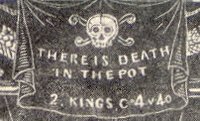
Today, Tuesday March 28th …
Frederick Accum was born on this day in 1769 in Germany. He grew up to be an analytical chemist, moved to Britain, and was an early and aggressive campaigner for pure food. In 1820 he published a treatise with the grand title of:
A Treatise on Adulterations of Food, and Culinary Poisons, Exhibiting the Fraudulent Sophistications of Bread, Beer, Wine, Spiritous Liquors, Tea, Coffee, Cream, Confectionery, Vinegar, Mustard, Pepper, Cheese, Olive Oil, Pickles, and other Articles Employed in Domestic Economy, and Methods of Detecting Them.
The book was known better by the phrase “There is Death in the Pot”, which he stole from 2 Kings, Ch. IV, v. 40, and which suited the sensationalist style. Accum not only described the common methods of adulteration, he actually named the perpetrators, not unsurprisingly making a lot of enemies in the process, and eventually having to return to Germany.
“Death in the Pot” was also appropriated by some nineteenth century vegetarians to signify the horrors of Meat in the Pot. To Dr J.H. Kellogg it was in the form of ‘diseased hogs for the dinner table’- the source of ‘loathsome parasites’ and ‘mysterious diseases’. Mary (Mrs. Horace) Mann was OK with meat, but death (and moral decay) came in the pot in the form of many other things, all detailed in her book “Christianity in the Kitchen” (1857). Alcohol, pie-crust made with butter or lard, turtle soup, wheat flour, vinegar and baking soda were indigestible, therefore un-Christian: “Why is not dyspepsia disgraceful, like delirium tremens?” she asked. Her list seems hardly in the same league as some of Accum’s examples: brick dust in cocoa, green vitriol or sulphate of iron to give beer a good ‘head’, alum in bread, and copper sulphate to colour pickles nice and green.
Her recipe for coconut pudding sounds pretty good, and using fresh coconut avoids the propylene glycol, sulphur dioxide and who knows what else in the supermarket dessicated kind.
Cocoa-nut pudding.
Grate a large cocoa-nut, and cook it thoroughly in hot milk. Add a large tumbler of grated bread, the same of sweet cream, half the tumbler of white sugar, five eggs, and flavour with rose water or lemon. It is best to beat the yolks of the eggs and cream together till they froth, add the well-beaten whites last. Line the dish with cream pastry; bake till the paste is cooked. Any other flavour may be added to the taste.
Tomorrow: Dangerous in translation.
1 comment:
This is really interesting. I wonder what they would have thought about all the artificial coloring and preservatives now in convenience foods.
Post a Comment